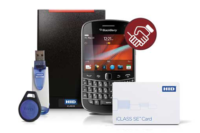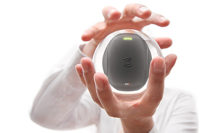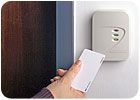
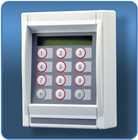
“Before these multi-technology readers, customers had to make a decision on what they were going to use,” says Matt Barnette, vice president of sales for AMAG Technology, Portland, Ore. “Once dealers rolled out the card technology to their users they were locked in. It was difficult to transition to any different technology. It meant replacing hardware on the walls, or it meant rebadging the entire population. You didn’t see corporations moving from one technology to another.”
That was then.
“Much of what you are seeing in the access control business today is designed to transition people from legacy technology to more current technology,” says Bob Holland, marketing manager for Secura Key, Chatsworth, Calif. “This is why you have multi-tech cards or readers.”
Increasingly, the technology that is being transitioned to is smart cards — a trend being driven by both the government’s FIPS 201-compliant PIV II and CAC NG cards and the convergence of physical security and IT security (who are often already relying on smart cards for logical access).
“I think there has been an emergence of more use of the Mifare technology in the last few years,” says John Menzel, CEO and president of XceedID, Golden, Colo. “It has been popular overseas for a long time, but with the government’s movement to smart cards and contactless smart card technology becoming more popular, it puts more focus on the fact that companies should be looking at contactless smart cards and not at proximity anymore.”
But often, just knowing where they want to go isn’t enough. The dealer or integrator can play a pivotal role in how the transition gets accomplished. And the first step is knowing which path to take.
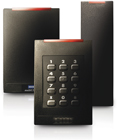
Cards or Readers?
Multi-tech readers are a transitional product, designed to read more than one card access technology until the end user has fully switched over to the ultimate one-card goal.“You will see companies with readers that can read proximity cards and also contactless smart cards,” Holland says. “Generally, anyone building a multi-tech reader is trying to help customers with their problem. A customer wants to upgrade, but say they have a huge card population. It might be cheaper to put in a multi-tech reader than rebadging the card population.”
Multi-tech cards, on the other hand, may be a transition product with more than one access control technology, or it may be a multi-use card with several functions on it.
“If you look at those cards, most of them consist of independent technologies that share the same piece of plastic: a prox card with mag stripe on the back, or a contactless card with Wiegand,” Holland says. “What happens in many of these cases is that each technology in the card is independent of the others. Someone may use prox for access and mag stripe for vending machines.”
Ultimately, the same smart card-based solution is often the goal, however. And the decision whether to get there using a multi-tech card or multi-tech reader is usually a matter of cost and the customer’s current configuration.
“When a customer wants to migrate [to smart cards] they can either change readers or change cards,” says Rick Focke, product manager, Software House – Access Control & Video Systems, Lexington, Mass. “A lot of times it’s a business decision. Usually you don’t see a multi-tech card and reader in the same job.”
The best choice often depends on the size of the card population, Barnette says. “If there is a very small card population, say several hundred to 1,000, it’s fairly easy to rebadge them. If you are going to have to rebadge 10,000 users, that becomes much more of a logistical problem.”
Conversely, if the customer has a lot of readers with different technologies, it might make more sense to go with a multi-tech card.
“Ideally if you are going in and selling someone a new installation, the cleanest thing is to sell the latest technology,” Holland says. “When do you need multi-technology? When you have someone who has a system and wants to upgrade to something new. You can use multi-tech cards or readers to get them to that point. The dealer has to look at where the greatest expenditure is. Rebadging can cost $40 to $50 per employee. I think that the circumstance is going to dictate whether to use one or the other. It’s really not a market. It’s a solution. It’s helping a customer with a problem.”
That is the main point, says Jack Bubany, director of product management, Credential Technology for HID, Irvine, Calif. “I think, really, the key is for a customer and a dealer to sit down together and understand what the requirements of the facility are. With that they can decide on a solution or package that will take them from where they are to where they want to go. Do they just want access control, or do they want a multi-application card for access control, logical access, biometrics, and stored value? They need to define this and then go out and select the solution that will work best for them.”
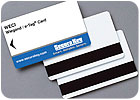
How it Works
For the most part, actually installing and using a multi-tech card or reader is the same as the single technologies. But there are some things to be aware of.The multi-tech reader, Bubany explains, will poll for all the technologies multiple times per second, looking for all the different types of cards.
“It reads each of them almost instantly to the naked eye,” he says. “It is pretty much transparent. The only thing to be concerned about is operating voltage range. Is the current consumption of the reader the same? In most cases it is, but in some cases not. Other than that it is easy to install and the wiring is basically the same.”
In fact, the basic multi-tech reader, Bubany says, is based on the single-tech reader. “What we’ve done in designing our multiCLASS readers is taken a look at what low frequency readers were out there. We took into account the wiring, form factor and power requirements to make sure that when that person removes the low frequency reader and replaces it with the multi-tech, it is almost plug-and-play. It therefore becomes very simple and transparent to both the installer and the end user. You don’t need to necessarily replace the controller. Just change the readers and start rebadging cards as you are able.”
HID is not alone in this approach.
“In its basic form, it is a standard reader, Focke says. “The only difference is if you want to set up smart card encryption with a custom key, it involves a little setup of the reader. But out of the box they function like standard readers.”
Setup issues are the only difference an installer will likely notice, Holland says. “Theoretically these readers should have a single Wiegand data output, standard power and current requirements. The installer should be able to take the old one out and put the new one in. But he has to be familiar with how it is configured if it is a multi-tech reader. The installer has to set the panel up to be ready for it.”
Another difference is that multi-tech readers have the ability to “turn off” one technology in favor of another — a benefit both short-term and long-term.
“If you want to read only proximity and not smart cards yet, you can turn off the smart card part of that reader,” Focke says. “Then you can turn it back on when you do have it. This provides you a little bit of a faster read, and in some cases it is done for security reasons.”
On the back end, the same holds true. “Once you have completed a transition [to smart cards], if you want to eliminate the possibility of reading a proximity card, you can shut off that portion so it no longer works,” Menzel says. “You can shut off any or several technologies.”
Bubany adds: “Once the migration is complete, the ability to deactivate the low frequency side of the reader provides customers with the complete security offered by smart cards (mutual authentication and data encryption).”

Why Offer It?
The biggest reason for an end user to consider multi-tech solutions is to plan for the future — either immediate or long-term. Being a part of this solution is a benefit for the dealer as well.“Say company X bought company Y,” says Mark Goldstein, senior product manager for Software House, Lexington, Mass. “For the dealer tasked to converge those sites, they can now provide a solution to company X by saying, “I can modify your system by adding multi-tech readers to take into account those new cards you acquired without changing your head-end system and without changing the cards.”
In another scenario, a dealer preparing for the smart card conversion can offer more to their customers than just a card and a reader.
“Because you are dealing with a card format that is bigger and can carry more information on it and can encrypt it, you have a higher level of security,” Goldstein adds. “Also because you can put more information there on a single card you can suit the purposes of multiple business applications.”
Menzel agrees. “For the dealer or integrator — at least the ones that embrace this recent movement to multi-tech readers — it allows them to make their customer look good. It’s a way to help the security managers be more prepared for what’s coming from IT departments and convergence. There are companies that have thousands of proximity cards and readers. If they can be sold on the idea of making every new installation a multi-tech reader as the new standard, they will be able to make the conversion on their own time and budget and migrate towards that eventual installed base so they can deploy smart cards.”
Cost-wise the difference between multi-tech and single-tech is generally the same or slightly higher. “Customers get the flexibility of having multiple technology readers for the same price,” Barnette says. “It allows them to future-proof what they can do with that reader because there is so much more capability.”
“Dealers and integrators need to understand the value proposition behind the multi-tech readers,” Menzel says. “It’s pretty simple to grasp. If they are not using them yet, try them. They are just like typical proximity readers, they just have a lot more horsepower. It’s something they should be doing anyway, because a lot of their competitors will be. If you don’t embrace what a lot of people are already doing, you are going to be left behind.”
Sidebar: Is there a future for “future-proof†technology?
Multi-tech cards and readers are, by definition, a “transitional” product. But what does that mean? Will they be a flash-in-the-pan, or are they here to stay?“Most companies and organizations would prefer to have a one-card technology,” says Matt Barnette, vice president of sales for AMAG Technology, Portland, Ore. “The military would like the CAC card. The government is the PIV card. But there is a light at the end of the tunnel that all these smart card technologies will come online. And if the government and military do it, the corporate world will follow suit. Prices will come down. It is still a transitional period, but I think the end result is coming faster.”
Depending on who you ask, however, “faster” could be anywhere from five to 20 years.
“I’d say we still have at least five to seven years of use, minimum,” Barnette says. “There are a lot of readers installed in the world.”
Based on the number of proximity cards in the population, Mark Goldstein, senior product manager for Software House, Lexington, Mass., estimates they will be around more like 10 to 20 years. “The HID prox card population alone is pretty large and embedded. It will take years and years to change.”
In practice, the multi-tech reader is a good bet for the foreseeable future. “Eventually the smart card technology will do what it is supposed to do,” says Bob Holland, marketing manager, Secura Key, Chatsworth, Calif. “Right now the honest truth is if you look at contactless smart cards, most are still used to open a door. All that power is unused. Most people buying contactless smart cards are doing it to future proof themselves in case some day they may do something with it. If you think about all the other applications, whether loyalty, laundry or library, you have all these little individual entrepreneurial companies. They would all have to target that technology. Getting all these to transition their applications to one ultimate technology will take more time than you might think.”
For the dealer, stocking multi-tech cards and readers is likely to be a long-term enterprise.
“I think they are transitional products, but they are here to stay after the transition,” says John Menzel, CEO and president of XceedID, Golden, Colo. “After we transition the old unsecured proximity cards to smart cards, the readers will stay in place. Because the pricing is very similar, it just makes sense, especially for large organizations, to have a reader that can read as many cards as possible.”

